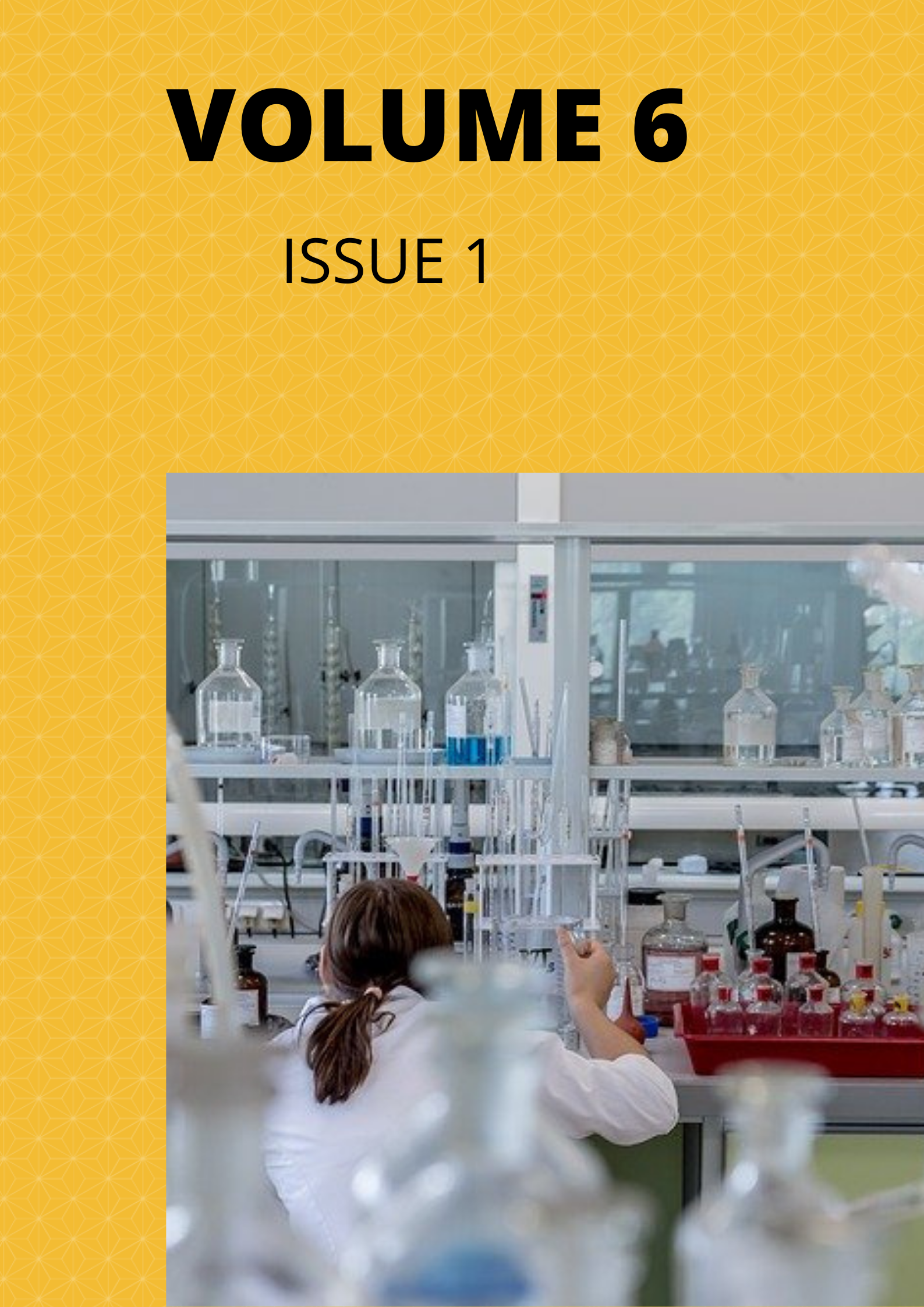Microbial Contamination of Infant Diapers
Keywords:
Microorganisms, contamination, diapers, bacterial isolates, fungal isolatesAbstract
This study investigated the microbial contamination of infant diapers. Five (5) different samples of infant diapers were used for this study. The results revealed that samples were contaminated by microorganisms. The highest bacterial count was recorded in sample 1 with a total bacterial count of 2.0 x 103 CFU/g, followed by sample 3 with a total bacterial count of 1.4 x 103 CFU/g. Sample 4 had a bacterial count of 1.3 x 103 CFU/g, sample 5 had a total bacterial count of 1.2 x 103 CFU/g while the least bacterial count was recorded in sample 2 with a total bacterial count of 1.0 x 103 CFU/g. The bacterial genera identified and their percentage frequency of occurrence were Bacillus sp.(29%), Staphylococcus sp.(35%), Pseudomonas sp.(12 %), Streptococcus sp.(24 %),while ,E.coli and Proteus sp. had 26 % percentage frequency of occurrence each respectively. The fungal count ranged between 1.0 x 103 to 1.6 x 103 CFU/g. The fungal isolates identified from this study and their percentage frequency of occurrence were Candida albicans (24 %), Penicillium sp.(19 %), Rhizopus sp.(10 %), Aspergillus sp.(14 %) and Mucor sp.(8 % ). Susceptibility results indicated that 95 % of that bacterial isolates were sensitive to Ciprofloxacin, Gentamycin, Levofloxacin, Oflaxacin, Ampicillin, Septrin, Ceprorex, Amoxil, Streptomycin, and Rifampicin. Five bacterial isolates were resistant to more than one class of antibiotics. E.coli. was resistant to Pefloxacin, Ceprorex, and Ampicillin. Pseudomonas sp. was resistant to Pefloxacin and Gentamycin. Proteus sp. was resistant to Septrin and Pefloxacin while Bacillus sp was resistant to Amoxil, Rifampicin and Chloramphenicol. The presence of these microbial contaminants in diapers could be attributed to existing of microorganisms in the raw materials during processing and manufacturing, packaging, storage, handling and transportation of this product. Hence, a routine microbial study is thus suggested.
Downloads
Published
Issue
Section
Most read articles by the same author(s)
- Imaobong T. Adenugba, Nkeneke E. Akpainyang , Emem I. Ntekpere, Eteyen A. Uko, Agnes M. Jones, Incidence of Tinea pedis and Eczema among Male and Female Students: Effect of Hydraulic Oil and Antifungal Creams , Communication In Physical Sciences: Vol. 6 No. 1 (2020): VOLUME 6 ISSUE 1
- Itoro U. Okon, Eteyen A. Uko, Aniebiet M. Essien, Rachel S. Okon, H. H. Oronubong, Application of Moringa oleifera as a Natural Coagulant for the Treatment of wastewater from Bakery and Brewery Industries in Uyo, Akwa Ibom State, Nigeria , Communication In Physical Sciences: Vol. 7 No. 4 (2021): VOLUME 7 ISSUE 4
Similar Articles
- Samuel A. Egu, Akachukwu Ibezim, Efeturi A. Onoabedje, Uchechukwu C. Okoro, N-Myristoyl Transferase Inhibitors with Antifungal Activity in Quinolinequinone Series: Synthesis, In-silico Evaluation and Biological Assay , Communication In Physical Sciences: Vol. 5 No. 4 (2020): VOLUME 5 ISSUE 4
- Agada Livinus Emeka, Adetola Sunday Oniku, Osita Meludu, Evaluation of Groundwater Potential in Gashua Northeast Nigeria, Using Electrical Resistivity Method , Communication In Physical Sciences: Vol. 5 No. 3 (2020): VOLUME 5 ISSUE 3
- Gideon Wyasu, Batch adsorption of Mn2+ and Co3+ from Refinery wastewater using activated carbon from epicarp of Detarium microcarpum and Balanites aegyptiaca shells , Communication In Physical Sciences: Vol. 3 No. 1 (2018): VOLUME 3 ISSUE 1
- Christopher Ejeomo, Ufuomaefe Oghoje, Composition and Distribution of Polynuclear Aromatic Hydrocarbons Contamination in Surficial Coastal Sediments from Odidi Area of Delta State, Nigeria , Communication In Physical Sciences: Vol. 11 No. 4 (2024): VOLUME 11 ISSUE 4
- Nsor Ofo Alobi, Onyeije Ugomma Chibuzo , Wood Saw Dust as Adsorbent for the Removal of Direct Red (DR) Dye from Aqueous Solution , Communication In Physical Sciences: Vol. 4 No. 2 (2019): VOLUME 4 ISSUE 2
- Blessing Ebong, Review on Microplastic-Polymer Composite Interactions: Assessing Contaminant Adsorption, Structural Integrity, and Environmental Impacts , Communication In Physical Sciences: Vol. 12 No. 3 (2025): VOLUME 12 ISSUE 3
- Mumini Itopa Abdulazeez, Habeeb Ayoola Ayinla, Jeremiah Ayok , Goodness Abraham, Zulaihat Jummai Sanni, Organic Petrographic Characterization and Paleodepositional Environment of Potential Source Rocks in the Patti Formation, Bida Basin, Nigeria , Communication In Physical Sciences: Vol. 12 No. 4 (2025): VOLUME1 2 ISSUE 4
- Joachim Johnson Awaka-Ama, Godwin James Udo, Emaime Jimmy Uwanta, Nsikan Jackson Etukudo, Nyeneime William Akpanudo, Raphael Igwe, Comparative Analysis of Heavy Metal Contamination in Regular and Artisanal Petroleum Products in Akwa Ibom State, South-South Nigeria , Communication In Physical Sciences: Vol. 11 No. 3 (2024): VOLUME 11 ISSUE 3
- A. O. Odiongenyi, Adsorption and Thermodynamic Studies on the Removal of Congo Red Dye from Aqueous Solution by Alumina and Nano-alumina , Communication In Physical Sciences: Vol. 4 No. 1 (2019): VOLUME 4 ISSUE 1
- Christabel M. Eteghwia, Enoo Ojaikre, Efeturi A. Onoabedje, Chinweike C. Eze, Patience O. Adomi, 7-Chloroquinoline Sulphonamide Derivatives: Synthesis, Characterization, Biological and Drug-likeness Evaluation , Communication In Physical Sciences: Vol. 12 No. 1 (2024): VOLUME 12 ISSUE 1
You may also start an advanced similarity search for this article.




